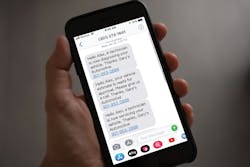They usually called around 10 a.m. and 2 p.m. with updates on customers’ services and found that, around those times, many customers wouldn’t answer their phones. Then, they found that customers rarely listened to the detailed voicemails discussing their updates, and didn’t know who to ask for when calling back.
So roughly a year and a half ago, Uhlman signed up for a comprehensive system that included digital inspections and text messaging services in an effort to communicate with customers conveniently on their own terms. Since implementing it, his ARO has gone up $75.
Chance Webb of La Vergne, Tenn.–based 1st Chance Tire and Automotive found similar issues in his shop, and wanted to be on the cutting edge of communication efforts, so he signed up with the same system about a year ago. Before he signed up for the service, he says his No. 1 customer complaint was a lack of communication regarding his shop’s services, but he’s gotten consistently great feedback on his new system.
While many shop owners are apprehensive about adopting a system like this, Webb says that communicating through text is actually much easier than calling or talking to a customer face to face.
“People want to communicate by text, whether they want to admit it or not,” Webb says. “I think people say they want face to face, but with text, they answer back within seconds.”
Webb says that he’s seen a major reduction in the amount of calls from customers inquiring about their services, and the new technology has helped him streamline communications with his client base.
“It’s been by far the single biggest change for the good that we’ve made throughout the years. I’ve yet to have a customer who didn’t like it,” Webb says.
Uhlman says the text services have made operations easier for his shop, and opened up communication levels to previously unseen levels with his customers.
“Everybody’s texting nowadays, and that seems to get the best response out of the customer,” Uhlman says. “Customers come in and say, ‘I love the fact that you sent me a text message, it’s so convenient.’”
After using this service for over a year, the two shop owners give details into how these services have provided a major benefit to their customer base.
How these systems work:
Webb has around 10 pre-programmed messages that can be sent out regarding simple updates, like if a customer’s car is being diagnosed or if their vehicle is ready for pickup. For questions or other concerns that require a customized message, these can be sent on any device you’re logged into, like a shop computer or personal cell phone.
The system is customizable based on how many messages your shop wants to send out or what you want to say, but there’s a general step-by-step process in sending these texts out:1. For Uhlman, his text messaging process is a bit different than Webb’s. Messages from Gary’s Automotive start when a customer calls and sets an appointment for service. His staff inputs the make and model of the car, the service requested, and most importantly, the customer’s cell phone number. He or she is then sent an automated text message that details the date and time of the appointment and serves as a reminder.
Some customers, usually older patrons, say they don’t text, and there's a feature that omits that method of communications from the services, if desired. But Webb says they’ve never had anyone upset about receiving the messages.
2. For Webb, this messaging process starts when the car comes in the shop, and is entered into the point-of-sale system. Once the customer concern is determined and a phone number is obtained, a staff member lets the customer know that in the next minute or two, he or she will receive an initial text as a way to open up the communication channel. This message says the customer is in line for service, and is welcome to reply back to the number with any questions. Once a customer checks in at Gary’s Automotive, he or she is moved into the workflow process on the system’s dashboard.
3. Once the service writer grabs the ticket, a button can be selected to tell the customer that a technician is now diagnosing or servicing the vehicle.
4. The digital vehicle inspection is sent out to the customer via text. This can be created through a tablet, or through an employee’s cell phone.
Uhlman finds that the staff often gets authorization of work done faster through text messaging.
“People message or call back within a minute or two,” Uhlman says. “We can never reach them by phone calls, so it’s sped up our work process tremendously.”
Uhlman makes sure to send his text message updates along with a phone call to fully update his customers on any service issues. Some customers, however, prefer to be solely texted.
5. If there are any parts that need to be ordered, a message can be sent out for this detailing the situation and when the parts will come in. If the technician has a question, or for example, is trying to find a wheel lock, a simple text can quickly find the answer, and speeds up the workflow process for technicians.
“You don’t want to bombard [customers], but if you can keep them posted about every hour or so, you rarely get a phone call in wondering where their car is and why it’s not ready,” Webb says.
6. The customer is sent a follow-up message detailing whether the service is scheduled to be completed on time after the service advisor looks through the system’s workflow chart. For customers at Gary’s Automotive, this message arrives around 2 p.m.
7. Once the service is done, the customer gets a final update, and is told to pick up his or her car. After the car is picked up, the text messages end—a shop can’t use texts as a tool to market to that customer in the future.

